Controlling the Structural, Mechanical and Frictional Properties of MoSx Coatings by High-Power Impulse Magnetron Sputtering
Abstract
:1. Introduction
2. Materials and Methods
3. Results and Discussion
3.1. Structural Properties of the MoSx Films
3.2. Mechanical and Tribological Properties
4. Conclusions
Author Contributions
Funding
Acknowledgments
Conflicts of Interest
References
- Brecher, C.; Spachtholz, G.; Bobzin, K.; Lugscheider, E.; Knotek, O.; Maes, M. Superelastic (Cr,Al)N coatings for high end spindle bearings. Surf. Coat. Tech. 2005, 200, 1738–1744. [Google Scholar] [CrossRef]
- Mattox, D.M. Handbook of Physical Vapor Deposition (PVD) Processing, 2nd ed.; William Andrew: Oxford, UK, 2010; ISBN 9780815520375. [Google Scholar]
- Janicki, M.; Temming, J.; Kauder, K.; Brümmer, A. Simulationsgestützte Entwicklung eines unsynchronisierten Schraubenladers. In (Hrsg.): Motorprozesssimulation und Aufladung II. Haus der Technik Fachbuch Band 83; Pucher, H., Kahrstedt, J., Eds.; Expert-Verlag: Tübingen, Germany, 2007; pp. 146–168. [Google Scholar]
- Nikolov, A.; Nadler, K.; Brümmer, A. Experimental and theoretical investigation of screw machines as vacuum blowers. In Proceedings of the 7th International Conference on Compressors and their Systems 2011, City University London, UK, 5–6 September 2011; Elsevier Science: Oxford, UK, 2011; pp. 359–374, ISBN 0857095358. [Google Scholar]
- Nikolov, A.; Brümmer, A. Investigating a Small Oil-Flooded Twin-Screw Expander for Waste-Heat Utilisation in Organic Rankine Cycle Systems. Energies 2017, 10, 869. [Google Scholar] [CrossRef] [Green Version]
- Moldenhauer, H.; Bayer, M.; Debus, J.; Nikolov, A.; Brümmer, A. Raman scattering study of micrometer-sized spots of magnetite and hematite formed at 18CrNiMo7-6 screw rotor surfaces due to liquid-free, unsynchronized operation. IOP Conf. Ser. Mater. Sci. Eng. 2018, 425, 12016. [Google Scholar] [CrossRef]
- Grieb, M.; Brümmer, A. Design and examination of a small-scale screw expander for waste heat recovery. In Proceedings of the International Conference on Screw Machines 2014, TU Dortmund University, Germany, 23–24 September 2014; VDI-Verl.: Düsseldorf, Germany, 2014; pp. 197–210, ISBN 978-3-18-092228-7. [Google Scholar]
- Holmberg, K.; Matthews, A. Coatings Tribology. Properties, Mechanisms, Techniques and Applications in Surface Engineering; Elsevier Professional: Oxford, UK, 2009; ISBN 978-0-444-52750-9. [Google Scholar]
- Wong, K.C.; Lu, X.; Cotter, J.; Eadie, D.T.; Wong, P.C.; Mitchell, K.A.R. Surface and friction characterization of MoS2 and WS2 third body thin films under simulated wheel/rail rolling–sliding contact. Wear 2008, 264, 526–534. [Google Scholar] [CrossRef]
- Wang, Z.M. MoS2: Materials, Physics, and Devices; Lecture Notes in Nanoscale Science and Technology; Springer: Cham, Switzerland, 2014; Volume 21, ISBN 9783319028507. [Google Scholar]
- Davim, J.P. Tribology of Nanocomposites; Springer: Berlin/Heidelberg, Germany, 2013; ISBN 9783642338816. [Google Scholar]
- Charoo, M.S.; Wani, M.F.; Hanief, M.; Rather, M.A. Tribological Properties of MoS2 Particles as Lubricant Additive on EN31 Alloy Steel and AISI 52100 Steel Ball. Mater. Today Proc. 2017, 4, 9967–9971. [Google Scholar] [CrossRef]
- Roberts, E.W. Ultralow friction films of MoS2 for space applications. Thin Solid Films 1989, 181, 461–473. [Google Scholar] [CrossRef]
- Nabot, J.-P.; Aubert, A.; Gillet, R.; Renaux, P. Cathodic sputtering for preparation of lubrication films. Surf. Coat. Technol. 1990, 43–44, 629–639. [Google Scholar] [CrossRef]
- Fleischauer, P.D.; Hilton, M.R.; Bauer, R. Effects of microstructure and adhesion on performance of sputter-deposited MoS2 solid lubricant coatings. Mech. Coat. Tribol. Ser. 1990, 17, 121–128. [Google Scholar] [CrossRef]
- Tillmann, W.; Wittig, A.; Stangier, D.; Thomann, C.-A.; Moldenhauer, H.; Debus, J.; Aurich, D.; Brümmer, A. Investigation of the Tribofilm Formation of HiPIMS Sputtered MoSx Thin Films in Different Environments by Raman Scattering. Lubricants 2019, 7, 100. [Google Scholar] [CrossRef] [Green Version]
- Li, Y.; Xie, M.; Sun, Q.; Xu, X.; Fan, X.; Zhang, G.; Li, H.; Zhu, M. The effect of atmosphere on the tribological behavior of magnetron sputtered MoS2 coatings. Surf. Coat. Technol. 2019, 378, 125081. [Google Scholar] [CrossRef]
- Aubert, A.; Nabot, J.P.; Ernoult, J.; Renaux, P. Preparation and properties of MoSx films grown by d.c. magnetron sputtering. Surf. Coat. Technol. 1990, 41, 127–134. [Google Scholar] [CrossRef]
- Bülbül, F.; Efeoğlu, İ. Synergistic effect of bias and target currents for magnetron sputtered MoS2 -Ti composite films. Mater. Test. 2016, 58, 471–474. [Google Scholar] [CrossRef]
- Vierneusel, B.; Tremmel, S.; Wartzack, S. Effects of deposition parameters on hardness and lubrication properties of thin MoS 2 films. Materialwiss. Werkst. 2012, 43, 1029–1035. [Google Scholar] [CrossRef]
- Bellido-González, V.; Jones, A.H.S.; Hampshire, J.; Allen, T.J.; Witts, J.; Teer, D.G.; Ma, K.J.; Upton, D. Tribological behaviour of high performance MoS2 coatings produced by magnetron sputtering. Surf. Coat. Technol. 1997, 97, 687–693. [Google Scholar] [CrossRef]
- Serpini, E.; Rota, A.; Ballestrazzi, A.; Marchetto, D.; Gualtieri, E.; Valeri, S. The role of humidity and oxygen on MoS2 thin films deposited by RF PVD magnetron sputtering. Surf. Coat. Technol. 2017, 319, 345–352. [Google Scholar] [CrossRef]
- Zhang, X.; Qiao, L.; Chai, L.; Xu, J.; Shi, L.; Wang, P. Structural, mechanical and tribological properties of Mo–S–N solid lubricant films. Surf. Coat. Technol. 2016, 296, 185–191. [Google Scholar] [CrossRef]
- Hilton, M.R.; Bauer, R.; Didziulis, S.V.; Dugger, M.T.; Keem, J.M.; Scholhamer, J. Structural and tribological studies of MoS2 solid lubricant films having tailored metal-multilayer nanostructures. Surf. Coat. Technol. 1992, 53, 13–23. [Google Scholar] [CrossRef]
- Roberts, E.W.; Williams, B.J.; Ogilvy, J.A. The effect of substrate surface roughness on the friction and wear of sputtered MoS2 films. J. Phys. D Appl. Phys. 1992, 25, A65–A70. [Google Scholar] [CrossRef]
- Wong, W.C.; Ng, S.M.; Wong, H.F.; Cheng, W.F.; Mak, C.L.; Leung, C.W. Effect of post-annealing on sputtered MoS2 films. Solid State Electron. 2017, 138, 62–65. [Google Scholar] [CrossRef]
- Gilmore, R.; Baker, M.A.; Gibson, P.N.; Gissler, W.; Stoiber, M.; Losbichler, P.; Mitterer, C. Low-friction TiN–MoS2 coatings produced by dc magnetron co-deposition. Surf. Coat. Technol. 1998, 108-109, 345–351. [Google Scholar] [CrossRef]
- Amaro, R.I.; Martins, R.C.; Seabra, J.O.; Renevier, N.M.; Teer, D.G. Molybdenum disulphide/titanium low friction coating for gears application. Tribol. Int. 2005, 38, 423–434. [Google Scholar] [CrossRef]
- Sun, L.; Ruan, T.; Yuan, Z.; Fang, Q.; Gong, W.; Wu, X.; Mei, S. Microstructures and properties of Mo2N+MoS2 coatings deposited by direct current magnetron sputtering. Vacuum 2020, 177, 109406. [Google Scholar] [CrossRef]
- Zhang, R.; Cui, Q.; Weng, L.; Sun, J.; Hu, M.; Fu, Y.; Wang, D.; Jiang, D.; Gao, X. Modification of structure and wear resistance of closed-field unbalanced-magnetron sputtered MoS2 film by vacuum-heat-treatment. Surf. Coat. Technol. 2020, 126215. [Google Scholar] [CrossRef]
- Ehiasarian, A.P.; Vetushka, A.; Hecimovic, A.; Konstantinidis, S. Ion composition produced by high power impulse magnetron sputtering discharges near the substrate. J. Appl. Phys. 2008, 104, 83305. [Google Scholar] [CrossRef]
- Lewin, E.; Loch, D.; Montagne, A.; Ehiasarian, A.P.; Patscheider, J. Comparison of Al–Si–N nanocomposite coatings deposited by HIPIMS and DC magnetron sputtering. Surf. Coat. Technol. 2013, 232, 680–689. [Google Scholar] [CrossRef]
- Kamath, G.; Ehiasarian, A.P.; Purandare, Y.; Hovsepian, P.E. Tribological and oxidation behaviour of TiAlCN/VCN nanoscale multilayer coating deposited by the combined HIPIMS/(HIPIMS-UBM) technique. Surf. Coat. Technol. 2011, 205, 2823–2829. [Google Scholar] [CrossRef]
- Ehiasarian, A.P.; Münz, W.-D.; Hultman, L.; Helmersson, U.; Petrov, I. High power pulsed magnetron sputtered CrNx films. Surf. Coat. Technol. 2003, 163, 267–272. [Google Scholar] [CrossRef]
- Bobzin, K.; Brögelmann, T.; Kruppe, N.C.; Basturk, S.; Klocke, F.; Mattfeld, P.; Trauth, D.; Hild, R. Synthesis, characterization, and tribological evaluation of HPPMS (Cr1−xAlx)N + MoSy coatings. Surf. Coat. Technol. 2016, 308, 383–393. [Google Scholar] [CrossRef]
- Moldenhauer, H.; Wittig, A.; Kokalj, D.; Stangier, D.; Brümmer, A.; Tillmann, W.; Debus, J. Resonant Raman scattering characterization of thermally annealed HiPIMS deposited MoS coatings. Surf. Coat. Technol. 2019, 377, 124891. [Google Scholar] [CrossRef]
- Tillmann, W.; Wittig, A.; Stangier, D.; Moldenhauer, H.; Thomann, C.-A.; Debus, J.; Aurich, D.; Bruemmer, A. Influence of the bias-voltage, the argon pressure and the heating power on the structure and the tribological properties of HiPIMS sputtered MoSx films. Surf. Coat. Technol. 2020, 385, 125358. [Google Scholar] [CrossRef]
- Arslan, E.; Baran, Ö.; Efeoglu, I.; Totik, Y. Evaluation of adhesion and fatigue of MoS2–Nb solid-lubricant films deposited by pulsed-dc magnetron sputtering. Surf. Coat. Technol. 2008, 202, 2344–2348. [Google Scholar] [CrossRef]
- Debus, J.; Schindler, J.J.; Waldkirch, P.; Goeke, S.; Brümmer, A.; Biermann, D.; Bayer, M. Indication of worn WC/C surface locations of a dry-running twin-screw rotor by the oxygen incorporation in tungsten-related Raman modes. Appl. Phys. Lett. 2016, 109, 171601. [Google Scholar] [CrossRef]
- Siu, K.W.; Ngan, A.H.W. The continuous stiffness measurement technique in nanoindentation intrinsically modifies the strength of the sample. Philos. Mag. 2013, 93, 449–467. [Google Scholar] [CrossRef]
- Oliver, W.C.; Pharr, G.M. An improved technique for determining hardness and elastic modulus using load and displacement sensing indentation experiments. J. Mater. Res. 1992, 7, 1564–1583. [Google Scholar] [CrossRef]
- Woo, S.; Park, H.C.; Son, Y.-W. Poisson’s ratio in layered two-dimensional crystals. Phys. Rev. B 2016, 93, 543. [Google Scholar] [CrossRef] [Green Version]
- Papa, F.; Gerdes, H.; Bandorf, R.; Ehiasarian, A.P.; Kolev, I.; Braeuer, G.; Tietema, R.; Krug, T. Deposition rate characteristics for steady state high power impulse magnetron sputtering (HIPIMS) discharges generated with a modulated pulsed power (MPP) generator. Thin Solid Films 2011, 520, 1559–1563. [Google Scholar] [CrossRef]
- Alami, J.; Sarakinos, K.; Mark, G.; Wuttig, M. On the deposition rate in a high power pulsed magnetron sputtering discharge. Appl. Phys. Lett. 2006, 89, 154104. [Google Scholar] [CrossRef] [Green Version]
- Lauwerens, W.; Wang, J.; Navratil, J.; Wieërs, E.; D’haen, J.; Stals, L.M.; Celis, J.P.; Bruynseraede, Y. Humidity resistant MoSx films prepared by pulsed magnetron sputtering. Surf. Coat. Technol. 2000, 131, 216–221. [Google Scholar] [CrossRef]
- Chromik, S.; Rosová, A.; Dobročka, E.; Kobzev, A.P.; Hulman, M.; Sojkova, M.; Hutár, P.; Machajdík, D. MoS2 thin films prepared by sulfurization. In Proceedings of the Nanoengineering, Fabrication, Properties, Optics, and Devices XIV. Nanoengineering: Fabrication, Properties, Optics, and Devices XIV, San Diego, CA, USA, 6–10 August 2017; SPIE Press: Bellingham, WA, USA, 2017; p. 56, ISBN 9781510611658. [Google Scholar]
- Shafi, P.M.; Bose, A.C. Impact of crystalline defects and size on X-ray line broadening: A phenomenological approach for tetragonal SnO2 nanocrystals. AIP Adv. 2015, 5, 57137. [Google Scholar] [CrossRef]
- Ingham, B.; Toney, M.F. X-ray diffraction for characterizing metallic films. In Metallic Films for Electronic, Optical and Magnetic Applications: Structure, Processing and Properties; Barmak, K., Coffey, K., Eds.; Woodhead Publishing Limited: Oxford, UK, 2014; pp. 3–38. ISBN 9780857090577. [Google Scholar]
- Lüth, H. Solid Surfaces, Interfaces and Thin Films; Springer: Berlin/Heidelberg, Germany, 2010; ISBN 9783642135910. [Google Scholar]
- Goloveshkin, A.S.; Bushmarinov, I.S.; Lenenko, N.D.; Buzin, M.I.; Golub, A.S.; Antipin, M.Y. Structural Properties and Phase Transition of Exfoliated-Restacked Molybdenum Disulfide. J. Phys. Chem. C 2013, 117, 8509–8515. [Google Scholar] [CrossRef]
- Mignuzzi, S.; Pollard, A.J.; Bonini, N.; Brennan, B.; Gilmore, I.S.; Pimenta, M.A.; Richards, D.; Roy, D. Effect of disorder on Raman scattering of single-layer MoS2. Phys. Rev. B 2015, 91. [Google Scholar] [CrossRef] [Green Version]
- Placidi, M.; Dimitrievska, M.; Izquierdo-Roca, V.; Fontané, X.; Castellanos-Gomez, A.; Pérez-Tomás, A.; Mestres, N.; Espindola-Rodriguez, M.; López-Marino, S.; Neuschitzer, M.; et al. Multiwavelength excitation Raman scattering analysis of bulk and two-dimensional MoS2: Vibrational properties of atomically thin MoS2 layers. 2D Mater. 2015, 2, 35006. [Google Scholar] [CrossRef] [Green Version]
- Molina-Sánchez, A.; Wirtz, L. Phonons in single-layer and few-layer MoS2 and WS2. Phys. Rev. B 2011, 84, 155413. [Google Scholar] [CrossRef] [Green Version]
- Najmaei, S.; Liu, Z.; Ajayan, P.M.; Lou, J. Thermal effects on the characteristic Raman spectrum of molybdenum disulfide (MoS2) of varying thicknesses. Appl. Phys. Lett. 2012, 100, 13106. [Google Scholar] [CrossRef] [Green Version]
- Qian, Q.; Zhang, Z.; Chen, K.J. In Situ Resonant Raman Spectroscopy to Monitor the Surface Functionalization of MoS2 and WSe2 for High-k Integration: A First-Principles Study. Langmuir 2018, 34, 2882–2889. [Google Scholar] [CrossRef]
- Vierneusel, B.; Schneider, T.; Tremmel, S.; Wartzack, S.; Gradt, T. Humidity resistant MoS2 coatings deposited by unbalanced magnetron sputtering. Surf. Coat. Technol. 2013, 235, 97–107. [Google Scholar] [CrossRef]
- Gao, F.M.; Gao, L.H. Microscopic models of hardness. J. Superhard Mater. 2010, 32, 148–166. [Google Scholar] [CrossRef] [Green Version]
- Sharma, K.K.; Sharma, L.K. A Textbook of Physical Chemistry. For BSc Students of All Indian Universities Under CBCS, 6th ed.; Vikas Publishing House: Noida, India, 2016; ISBN 9352590422. [Google Scholar]
- Zhang, S. Nanostructured Thin Films and Coatings. Mechanical Properties; CRC Press: Hoboken, NJ, USA, 2010; ISBN 9781420094022. [Google Scholar]
- Zhang, X.; Vitchev, R.G.; Lauwerens, W.; Stals, L.; He, J.; Celis, J.-P. Effect of crystallographic orientation on fretting wear behaviour of MoSx coatings in dry and humid air. Thin Solid Films 2001, 396, 69–77. [Google Scholar] [CrossRef]
- Didziulis, S.V.; Fleischauer, P.D.; Soriano, B.L.; Gardos, M.N. Chemical and tribological studies of MoS2 films on SiC substrates. Surf. Coat. Technol. 1990, 43–44, 652–662. [Google Scholar] [CrossRef]
- Lundin, D.; Minea, T.; Gudmundsson, J.T. (Eds.) High Power Impulse Magnetron Sputtering. Fundamentals, Technologies, Challenges and Applications; Elsevier: Amsterdam, The Netherlands, 2020; ISBN 0128124547. [Google Scholar]

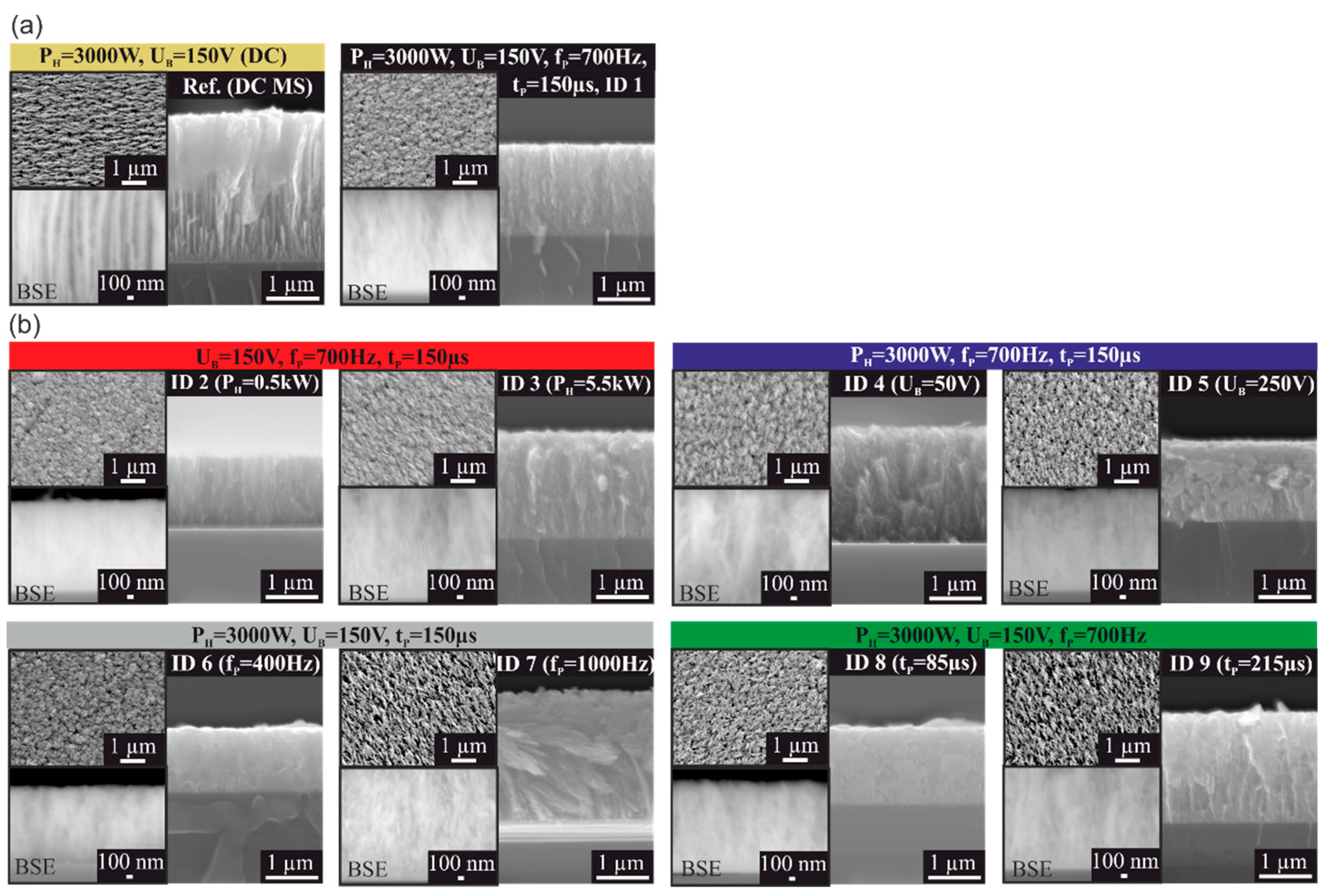
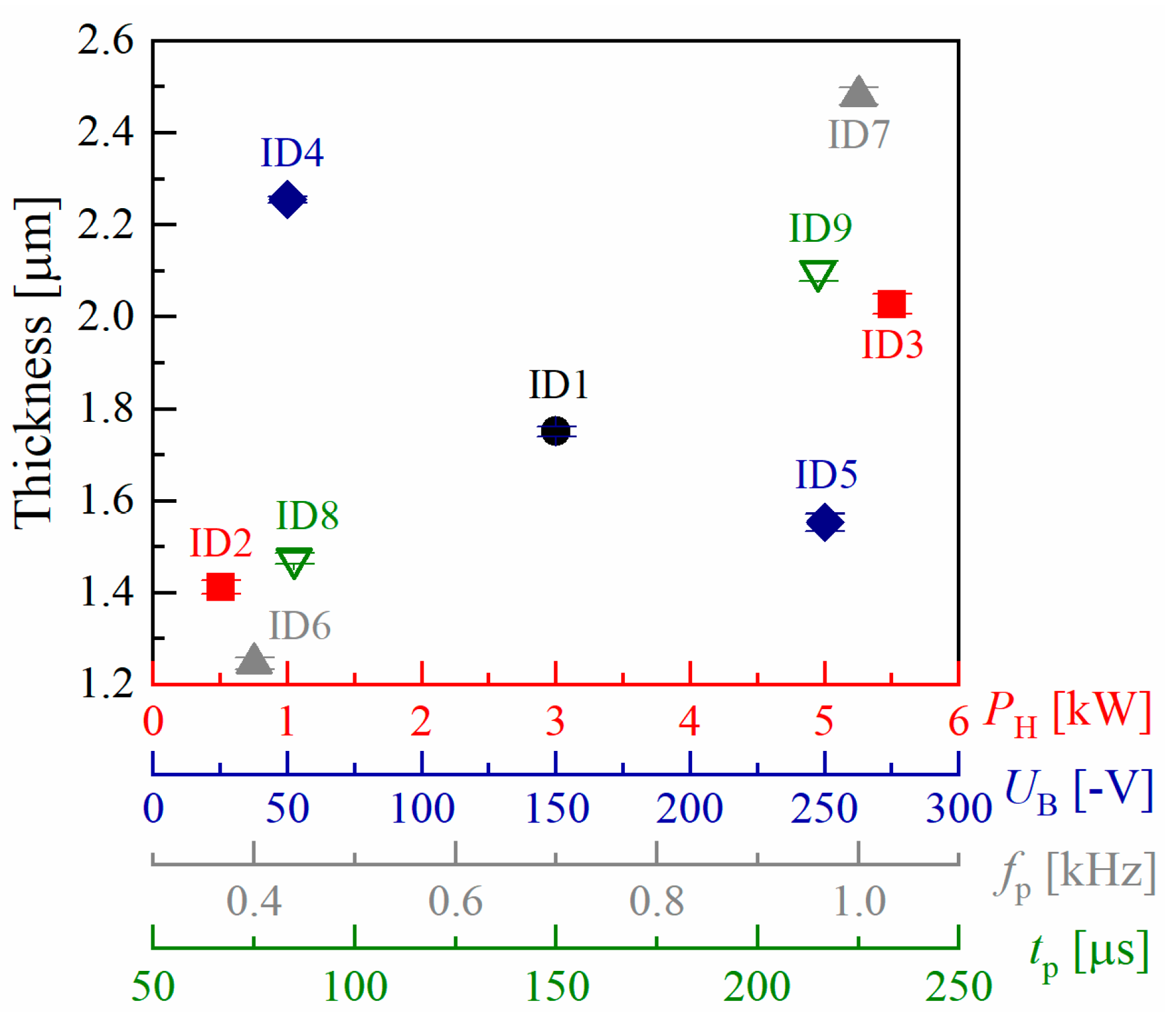
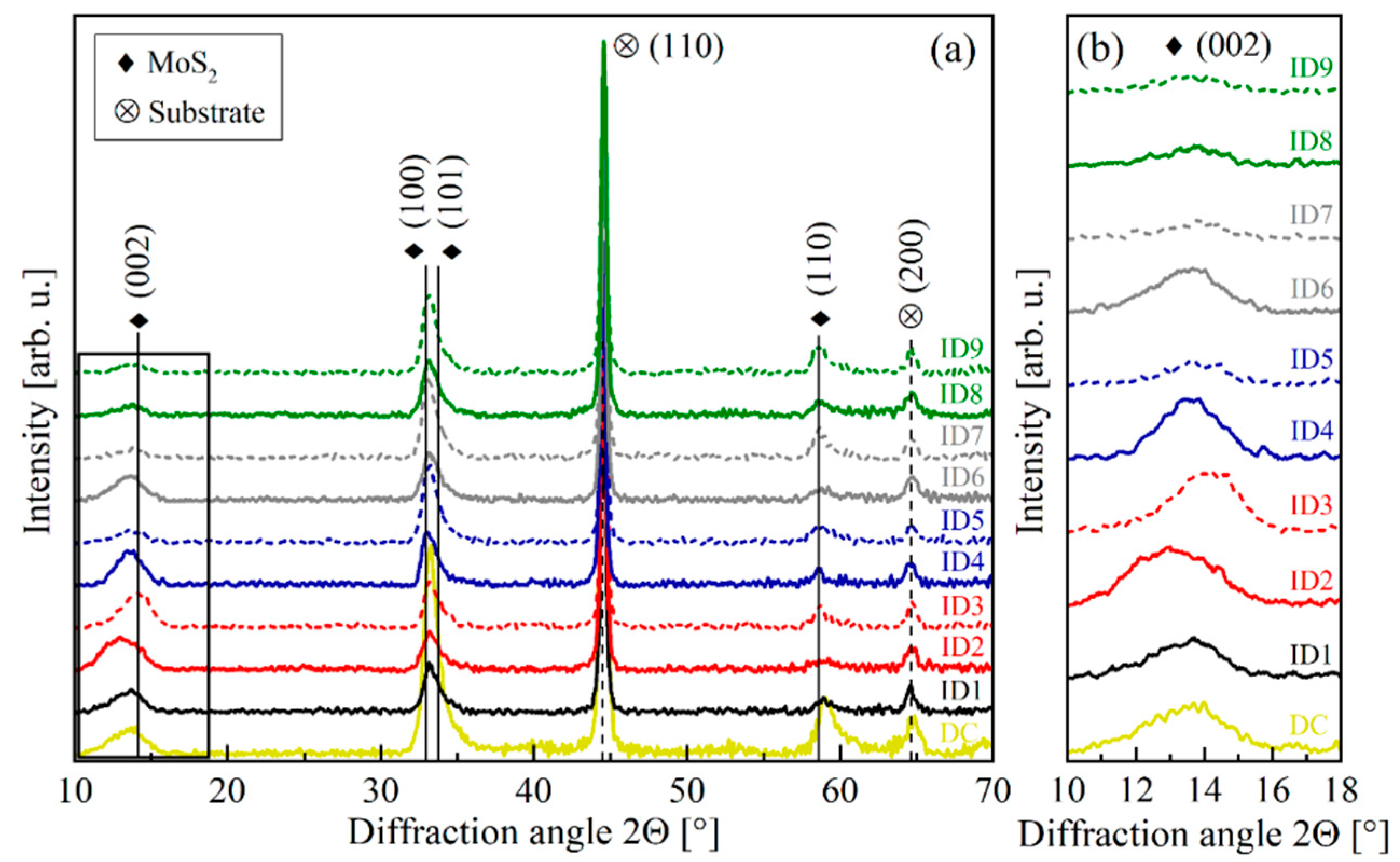

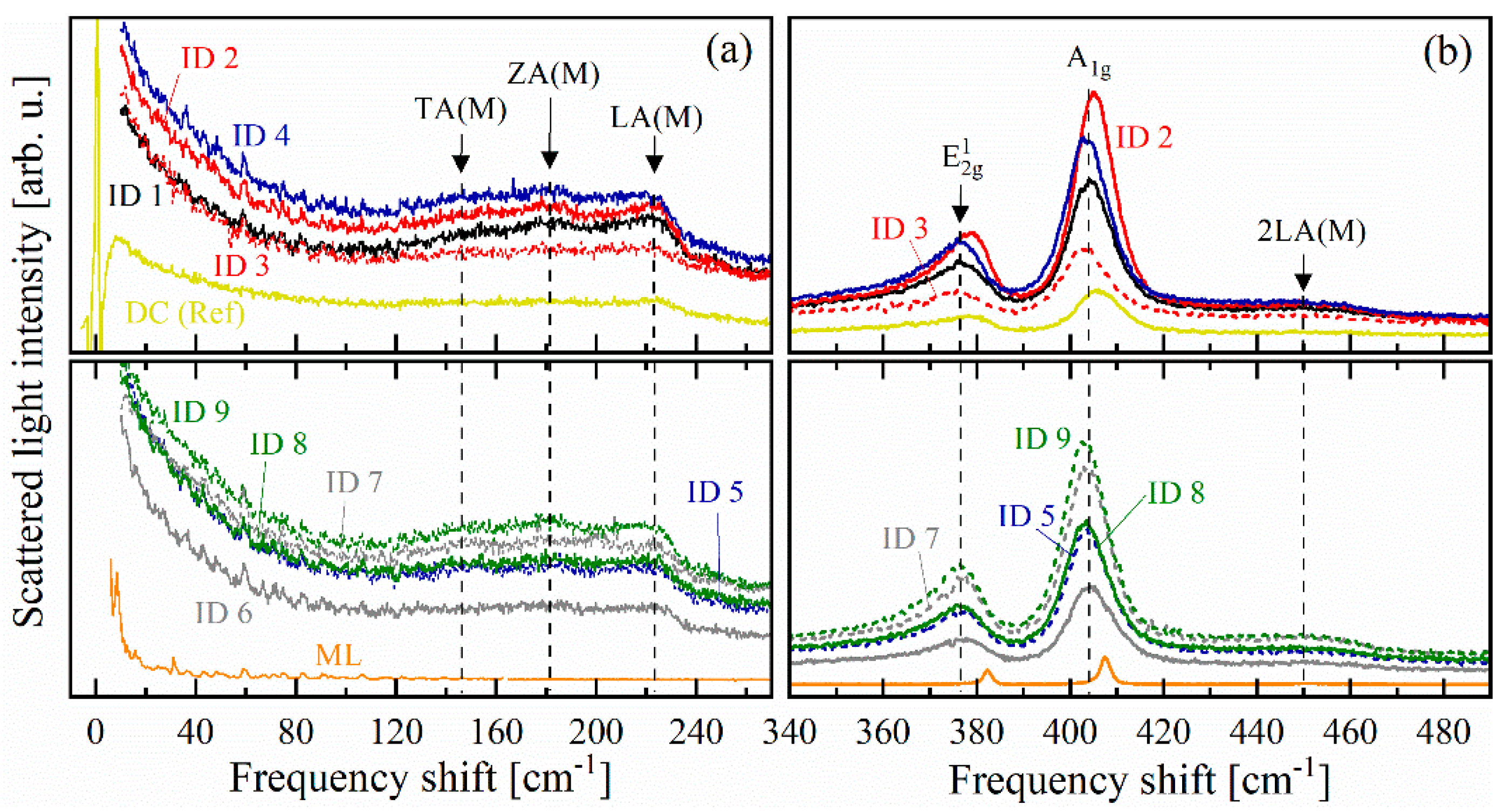
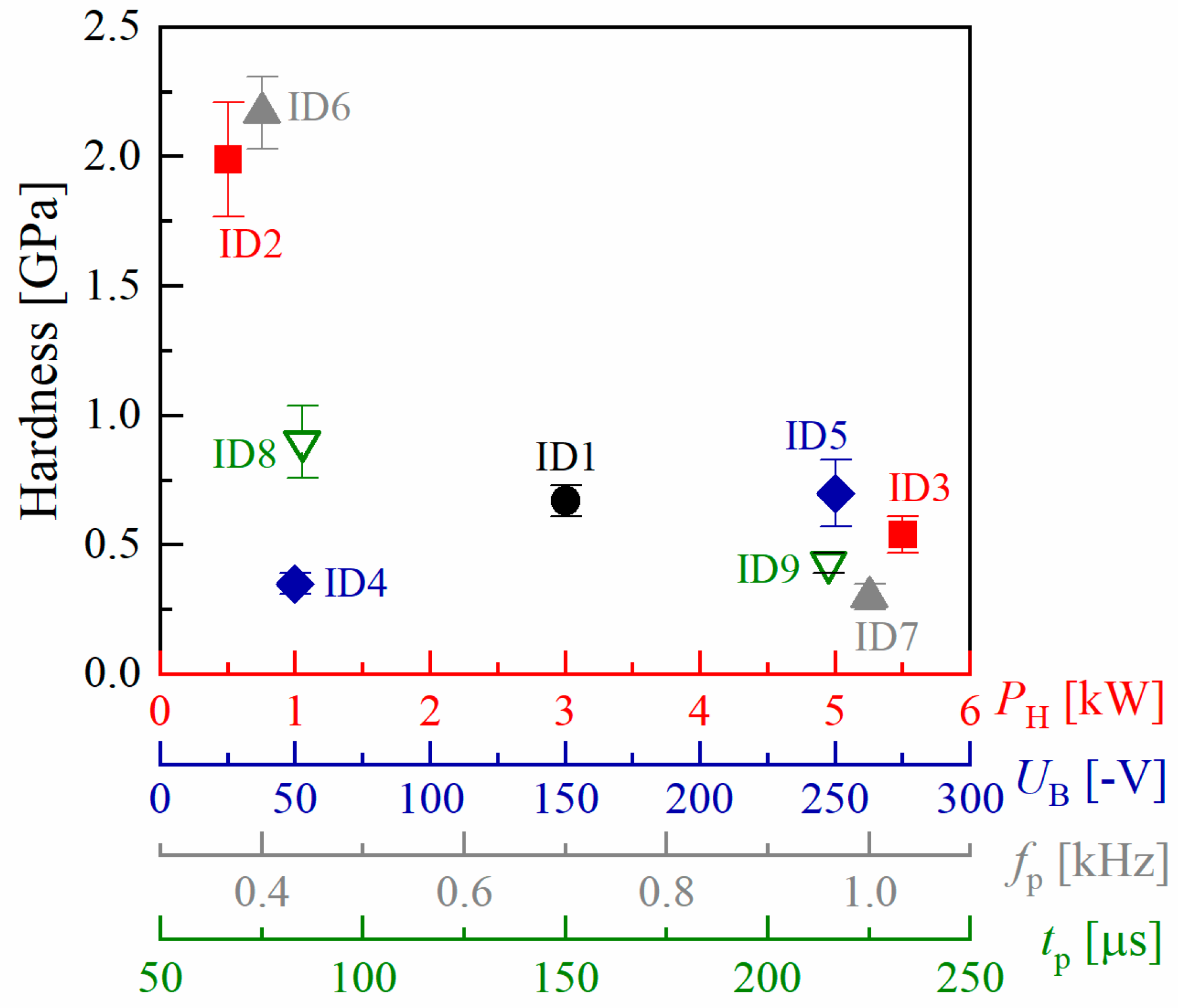
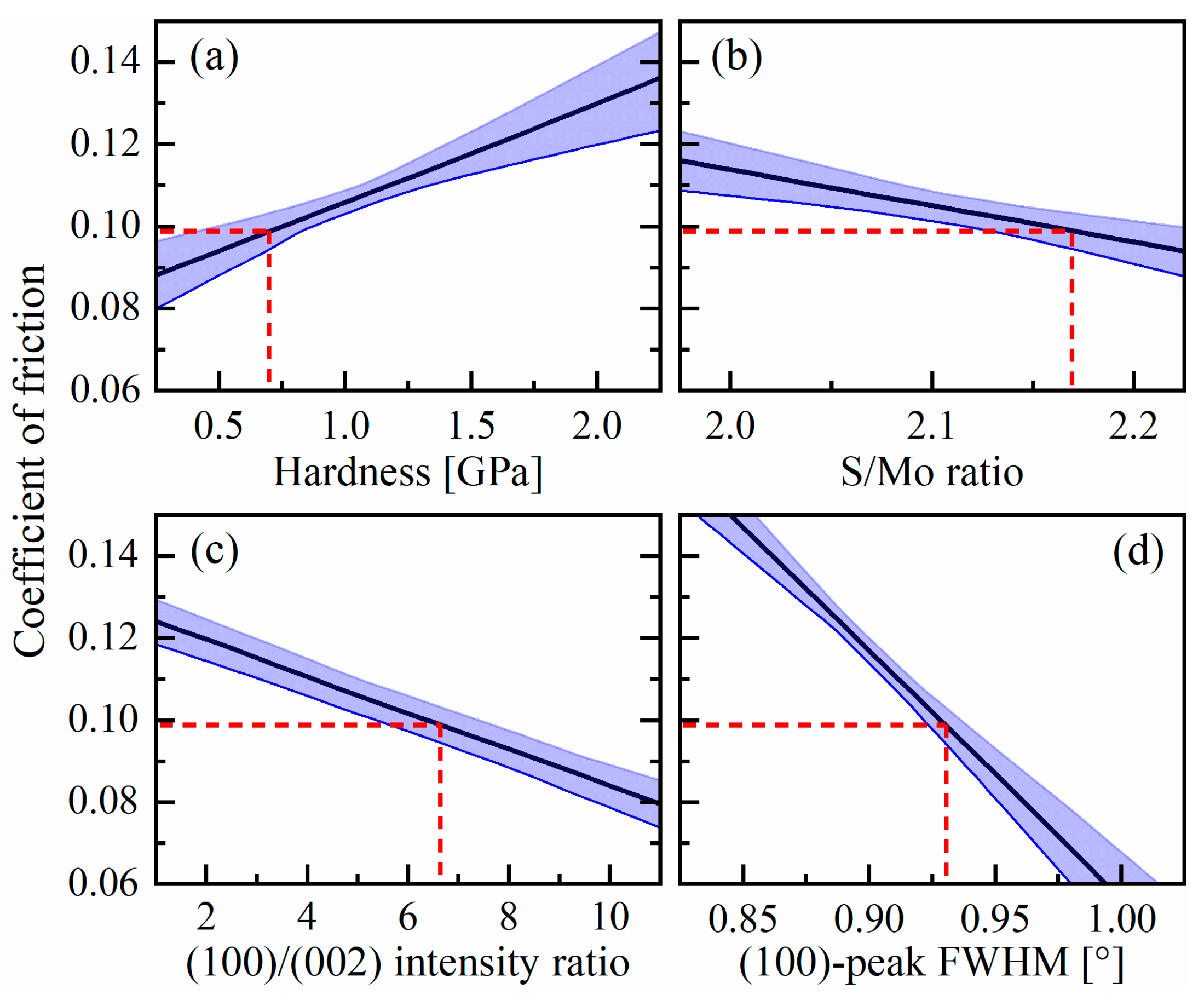
| ID | PH (W) | UB (V) | fp (Hz) | tp (µs) | TS (°C) | d (µm) | Ra (nm) | Mo (at.%) | S (at.%) | S/Mo Ratio | (100)/ (002) |
|---|---|---|---|---|---|---|---|---|---|---|---|
| DC | 3000 | 150 | – | – | 312 ± 1 | 2.70 ± 0.02 | 79.1 ± 1.5 | 38.62 ± 0.25 | 66.38 ± 0.25 | 1.59 ± 0.02 | 7.8 ± 0.4 |
| 1 | 3000 | 150 | 700 | 150 | 311 ± 5 | 1.75 ± 0.01 | 18.6 ± 0.7 | 33.07 ± 0.22 | 66.93 ± 0.22 | 2.02 ± 0.02 | 2.2 ± 0.1 |
| 2 | 500 | 150 | 700 | 150 | 128 ± 1 | 1.41 ± 0.01 | 13.1 ± 1.1 | 31.02 ± 0.45 | 68.89 ± 0.45 | 2.22 ± 0.05 | 1.2 ± 0.1 |
| 3 | 5500 | 150 | 700 | 150 | 388 ± 5 | 2.03 ± 0.02 | 21.6 ± 2.0 | 32.43 ± 0.30 | 67.57 ± 0.30 | 2.08 ± 0.03 | 1.4 ± 0.1 |
| 4 | 3000 | 50 | 700 | 150 | 308 ± 2 | 2.26 ± 0.01 | 22.4 ± 3.2 | 32.20 ± 0.11 | 67.80 ± 0.11 | 2.11 ± 0.01 | 1.6 ± 0.1 |
| 5 | 3000 | 250 | 700 | 150 | 306 ± 1 | 1.55 ± 0.02 | 18.6 ± 3.5 | 31.54 ± 0.20 | 68.46 ± 0.20 | 2.17 ± 0.02 | 6.7 ± 0.3 |
| 6 | 3000 | 150 | 400 | 150 | 306 ± 1 | 1.25 ± 0.01 | 12.7 ± 0.5 | 31.97 ± 0.32 | 68.03 ± 0.32 | 2.14 ± 0.03 | 1.9 ± 0.1 |
| 7 | 3000 | 150 | 1000 | 150 | 308 ± 1 | 2.48 ± 0.02 | 29.3 ± 0.6 | 32.38 ± 0.16 | 67.62 ± 0.16 | 2.09 ± 0.02 | 9.4 ± 0.1 |
| 8 | 3000 | 150 | 700 | 85 | 306 ± 1 | 1.47 ± 0.01 | 16.9 ± 3.3 | 31.46 ± 0.18 | 68.54 ± 0.18 | 2.18 ± 0.02 | 3.7 ± 0.4 |
| 9 | 3000 | 150 | 700 | 215 | 305 ± 1 | 2.10 ± 0.02 | 80.3 ± 3.7 | 31.77 ± 0.24 | 68.23 ± 0.24 | 2.15 ± 0.02 | 10.6 ± 0.8 |
| Deposition Parameter | p-Value | t-Value | Deposition Parameter | p-Value | t-Value |
|---|---|---|---|---|---|
| Roughness | Coating Thickness | ||||
| Pulse duration | 0.0663 | 2.51 | Pulse frequency | 0.0004 | 11.00 |
| Pulse frequency | 0.5500 | 0.65 | Bias-voltage | 0.0032 | −6.33 |
| Substrate temperature | 0.6222 | 0.53 | Substrate temperature | 0.0043 | 5.85 |
| Bias-voltage | 0.8908 | −0.15 | Pulse duration | 0.0048 | 5.68 |
| S/Mo Ratio | Full width at Half Maximum (FWHM) of (100)-XRD Peak | ||||
| Substrate temperature | 0.1466 | −1.80 | Pulse frequency | 0.0092 | −4.72 |
| Bias-voltage | 0.5240 | 0.70 | Substrate temperature | 0.0642 | −2.54 |
| Pulse frequency | 0.5936 | −0.58 | Bias-voltage | 0.1260 | 1.93 |
| Pulse duration | 0.7358 | −0.36 | Pulse duration | 0.1395 | −1.84 |
| (100)/(002)-XRD Intensity Ratio | (002)-XRD Peak Position | ||||
| Pulse frequency | 0.1692 | 1.68 | Substrate temperature | 0.0019 | 7.27 |
| Pulse duration | 0.1970 | 1.55 | Pulse frequency | 0.0763 | 2.38 |
| Bias-voltage | 0.3160 | 1.15 | Pulse duration | 0.4037 | −0.93 |
| Substrate temperature | 0.6466 | 0.49 | Bias-voltage | 0.4382 | 0.86 |
| Hardness | Friction Coefficient (Uncoated Counter Body) | ||||
| Pulse frequency | 0.0303 | −3.29 | Bias-voltage | 0.0661 | −2.51 |
| Substrate temperature | 0.0439 | −2.90 | Pulse frequency | 0.2790 | 1.25 |
| Pulse duration | 0.4471 | −0.84 | Substrate temperature | 0.4365 | 0.86 |
| Bias-voltage | 0.5280 | 0.60 | Pulse duration | 0.9976 | 0.00 |
| ID | H (GPa) | E (GPa) | H/E Ratio | µ 100Cr6 cb | µ MoSx cb |
|---|---|---|---|---|---|
| DC | 0.4 ± 0.1 | 33.7 ± 3.1 | 0.012 ± 0.001 | 0.05 ± 0.01 | 0.10 ± 0.03 |
| 1 | 0.7 ± 0.1 | 50.9 ± 3.4 | 0.013 ± 0.001 | 0.13 ± 0.01 | 0.14 ± 0.02 |
| 2 | 2.0 ± 0.2 | 78.8 ± 8.8 | 0.025 ± 0.004 | 0.12 ± 0.02 | 0.11 ± 0.01 |
| 3 | 0.5 ± 0.1 | 41.6 ± 3.9 | 0.013 ± 0.001 | 0.15 ± 0.05 | 0.18 ± 0.08 |
| 4 | 0.4 ± 0.1 | 28.6 ± 2.6 | 0.012 ± 0.001 | 0.16 ± 0.03 | 0.14 ± 0.03 |
| 5 | 0.7 ± 0.1 | 47.4 ± 6.9 | 0.015 ± 0.001 | 0.10 ± 0.02 | 0.09 ± 0.01 |
| 6 | 2.2 ± 0.1 | 90.3 ± 8.6 | 0.024 ± 0.002 | 0.10 ± 0.02 | 0.10 ± 0.02 |
| 7 | 0.3 ± 0.1 | 31.5 ± 4.2 | 0.010 ± 0.001 | 0.13 ± 0.02 | 0.13 ± 0.02 |
| 8 | 0.9 ± 0.1 | 60.1 ± 7.2 | 0.015 ± 0.002 | 0.11 ± 0.02 | 0.10 ± 0.02 |
| 9 | 0.4 ± 0.1 | 39.9 ± 2.9 | 0.011 ± 0.001 | 0.11 ± 0.02 | 0.12 ± 0.03 |
© 2020 by the authors. Licensee MDPI, Basel, Switzerland. This article is an open access article distributed under the terms and conditions of the Creative Commons Attribution (CC BY) license (http://creativecommons.org/licenses/by/4.0/).
Share and Cite
Kokalj, D.; Debus, J.; Stangier, D.; Moldenhauer, H.; Nikolov, A.; Wittig, A.; Brümmer, A.; Tillmann, W. Controlling the Structural, Mechanical and Frictional Properties of MoSx Coatings by High-Power Impulse Magnetron Sputtering. Coatings 2020, 10, 755. https://doi.org/10.3390/coatings10080755
Kokalj D, Debus J, Stangier D, Moldenhauer H, Nikolov A, Wittig A, Brümmer A, Tillmann W. Controlling the Structural, Mechanical and Frictional Properties of MoSx Coatings by High-Power Impulse Magnetron Sputtering. Coatings. 2020; 10(8):755. https://doi.org/10.3390/coatings10080755
Chicago/Turabian StyleKokalj, David, Jörg Debus, Dominic Stangier, Henning Moldenhauer, Alexander Nikolov, Alexandra Wittig, Andreas Brümmer, and Wolfgang Tillmann. 2020. "Controlling the Structural, Mechanical and Frictional Properties of MoSx Coatings by High-Power Impulse Magnetron Sputtering" Coatings 10, no. 8: 755. https://doi.org/10.3390/coatings10080755





